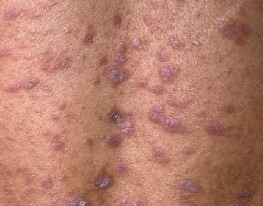About Us


Lichen planus is a common
inflammatory skin disease, which
can sometimes also affect the
mouth, the scalp and the nails.
Lichen planus
Lichen planus is a common inflammatory skin disease, which can sometimes also affect the mouth, the scalp and the nails. It affects around 1 in 100 Indians at some point in their lives, and is most commonly seen in the middle-aged.
Lichen planus looks like purple or reddish-purple bumps on the skin. New lesions might show scaling. Although the bumps can occur in any area of the skin, it is typically seen on the wrists, shins, ankles and around the genital areas. The bumps are itchy, flat-topped and have an irregular shape. In the mouth, it can cause pain and burning sensation. Sometimes, new bumps can appear around a fresh scratch or wound. Severe and explosive cases might develop fluid- filled blisters as well.
When the bumps heal with appropriate medication, they will leave areas of dark brown pigmentation. This pigmentation tends to persist for several months before it slowly starts to face away.
Lichen planus is NOT contagious and is NOT related to personal hygiene. Lichen planus is sometimes hereditary though this is not a rule. It may occur following some infections, notably Hepatitis C, or with hormonal imbalances, notably thyroid disease. These may have to be ruled out with some blood tests.
Lichen planus-like rash is common in those taking certain medications like heart or blood pressure medications. Lichen planus of the mouth can occur following dental fillings with mercury or gold. Stress can aggravate the itching, although it cannot cause lichen planus per se. However, in most cases, no definite cause can be identified.
Most dermatologists believe that Lichen planus is an autoimmune disease. That is to say, the white cells in our blood which police our body against infections and cancers, sometimes get misguided into attacking the normal parts of the skin, mouth, hair and/or nails.
Lichen planus is best diagnosed by a dermatologist, who may ask you to undergo some blood tests and a skin biopsy. A skin biopsy is a simple out-patient procedure which takes only 10 minutes.
After injecting a small amount of anesthetic into your skin, a 4mm bit of your skin is taken in order to study it under a microscope. A single suture is placed to minimize the risk of a scar at the biopsy site.
There is no definite cure for Lichen planus, but medicines can make the itching and rash get better. In most cases, the bumps regress in less than a year. If you only have a few bumps, they can be cleared with a cream.
If you have several bumps all over your body, you will be treated with tablets or light therapy. Lichen planus of the mouth can be painful and need to be treated soon, so that they do not compromise your eating habits and your nutrition.
